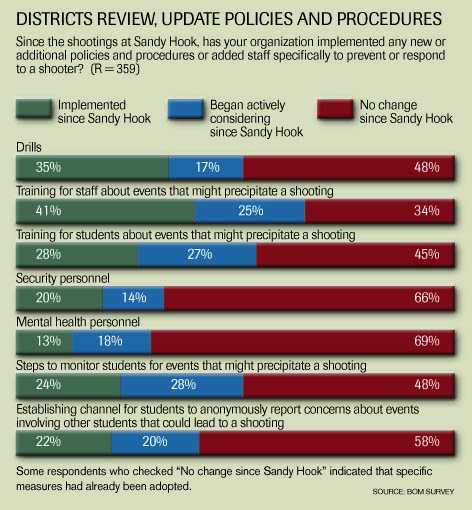Policies Can Help School Districts Mitigate, Prevent Shootings
Along with boosting the physical safety features of their school buildings, many school districts are implementing policies aimed at making the facilities safer for students, staff, and visitors. These policies can help mitigate or prevent shootings in schools. This is key, as even the most sophisticated technology in the world, by itself, isn't enough. "The issue is not really one of security technology advancing," says Ken Trump, president of National School Safety and Security Services, citing such admittedly extreme examples as bulletproof backpacks and white boards. "These all meet emotional security needs, but in reality, will do little — and may even create a false sense of unrealistic security — to actually make kids, teachers, and schools more safe."
To be most effective, technology needs to be deployed prudently and in conjunction with trained employees and intelligent policies.
1. Identify risks. "Develop a prioritized list of risks and hazards," says Steven Healy, managing partner and co-founder of consulting firm Margolis Healy.
The goal is to think through possible scenarios and appropriate courses of action before an incident occurs and critical decisions need to be made quickly. For instance, "do we evacuate or go to safe centers within the building?" asks Roberta DiLorenzo, superintendent with Washington School District in southwestern Pennsylvania. "According to the crisis at hand, what is the best solution?"
Once a district or school has identified the likelihood and impact of potential risks, it can develop reasonable, relevant prevention and mitigation strategies.
2. Emphasize respect. Security experts and school administrators alike emphasize the importance of fostering a culture of respect, which can limit bullying and keep disagreements from escalating.
DiLorenzo says the teachers in her district approach the topic with behavior expectations reasonable to students' ages. These apply in the classroom, the hallways, and even on the buses.
At Ball Chatham school district in Illinois, students learn about "SWAT," for "stop, walk and talk," says Jill Larson, assistant superintendent. Students are instructed stop, walk away, and tell an adult if another person is hurting them or making them feel uncomfortable.
In addition, teachers talk about respect and safety in their classrooms, Larson says. It's part of building relationships between teachers and students, so students are comfortable reporting incidents that could be cause for concern.
3. Be aware of visitors. Staff members should know to watch for and engage visitors in the facility, as this forms a second line of defense, says Amy Klinger, director of programs with Educator's School Safety Network. Simply walking up to the visitor and saying something like, "Good morning, how can we help you?" not only helps legitimate visitors feel welcome, but lets those who aren't supposed to be in the building know that their presence has been noted.
The idea isn't that school employees start confronting visitors or taking them into custody, but that they're aware of outsiders in the building, and know whom to call when someone's behavior raises a red flag — for example, if the visitor is aggressive or evasive.

Related Topics:














